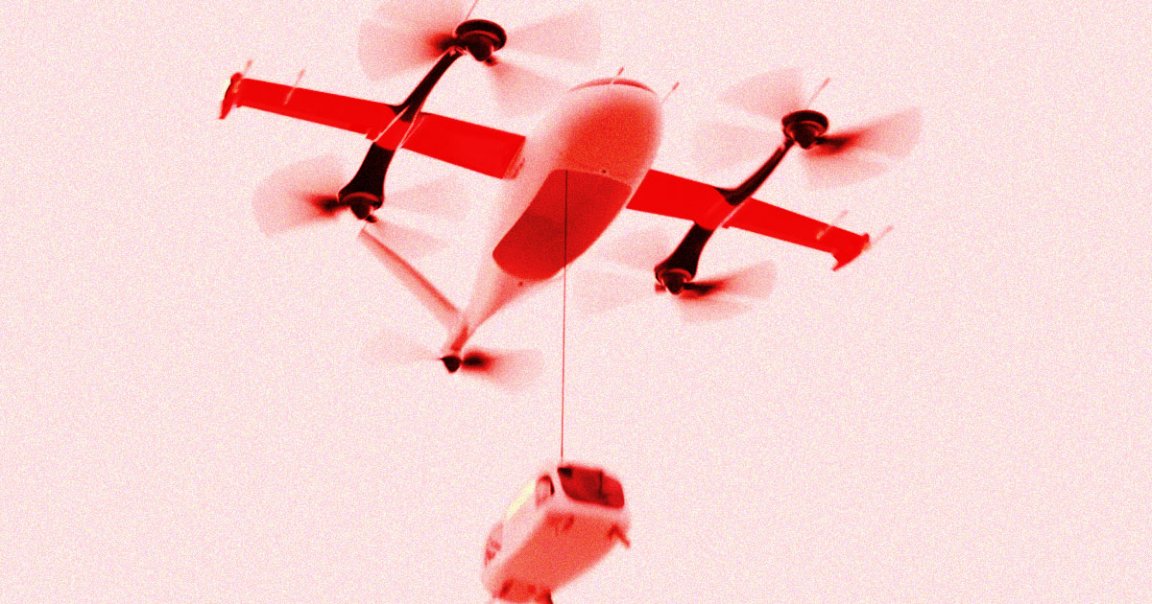
Most delivery drones look like droids too dumb for Star Wars, or dystopian gnats people want to shoot from the sky — until now. Meet Zipline, the adorable, Jetson-esque delivery drone of your dreams, as debuted today in a series of Tweets on Twitter by its founder.
Watch this:
4/ The first innovation is the delivery droid, enabling us to safely deliver into small, protected, (often cluttered!) environments. Let's dig into how this cute lil bot works… pic.twitter.com/VPdF4A1o2T
— Ryan Oksenhorn (@ryanzip) March 15, 2023
According to Zipline founder Ryan Oksenhorn, after “tens of millions of miles” delivering packages via the ol’ oopsie daisy method of just parachuting stuff from a drone in the sky, they’ve cooked up a better way to deliver by drone — one that’s cuter, and more importantly, has a hell of a lot less room for error.
The way it works: Zipline’s “mamma drone” hovers silently a few hundred feet in the air, and dispatches downward a tethered baby delivery drone containing your package. The delivery drone, which
contains its own thrusters to compensate for wind and downward inertia, “dynamically identifies” its landing target. Once it lands, it drops your package through a cargo bay in its belly, closes the bay, and zips right back up to the mamma drone — all, apparently, in ten seconds. Adorable!
1/ Today, Zipline unveiled our next generation delivery drone system, designed to provide the best home delivery service the planet has ever seen. It's so out-there that you probably won't believe your eyes… 🧵 pic.twitter.com/Ks7df4DVKD
— Ryan Oksenhorn (@ryanzip) March 15, 2023
Oksenhorn, who called his system the best home delivery system “the planet has ever seen,” explained that his drone had to past what they call the “neighbor test,” as in, it should be so silent, your neighbors shouldn’t be able to tell it’s even making a delivery. He also claimed the drones — which, according to Zipline’s website, can race to its destination at speeds up to 70 MPH — can deliver in all weather conditions, using the aforementioned thrusters and motion sensors.
As for loading the drones, they start on rail
systems, guided to users dropping packages into them. Then, the drones then shoot out to their delivery sites — kind of like the pneumatic tubes you might at your local drive-through bank or pharmacy. The drones would operate on dock/charging
systems businesses could theoretically order by the tens, or hundreds. Most impressively, Oksenhorn claims that Zipline drones use 34 times less carbon than gas-powered cars (and “nearly 9x” less electric cars).
It’s difficult to verify those numbers without more data — for example, we don’t know exactly how much power the chargers use, how much power the drones can store, and how long these drones would last on a single charge. That’s all to say nothing of the economics of it. How much are they to purchase? Or operate, and perform maintenance on?
Whether or not these questions have sufficient answers (or if this thing even makes it past a series of Tweets) not withstanding, Oksenhorn’s vision of delivery drones — quiet, accurate, efficient, environmentally sound, and definitely adorable — are part of an all-too-rare visage of a charming, functional, Jetsons-esque future filled with whimsical (if not truly useful) changes to the way we live our lives.